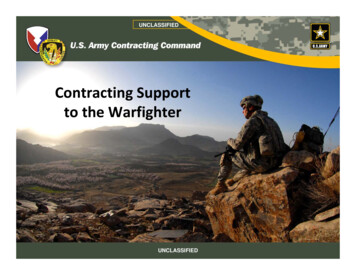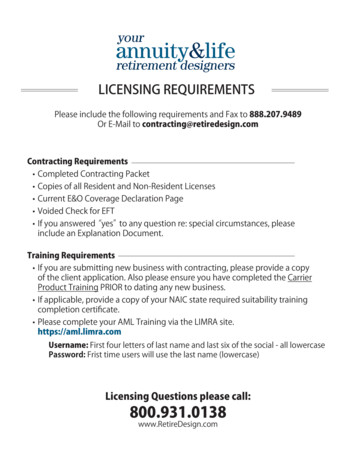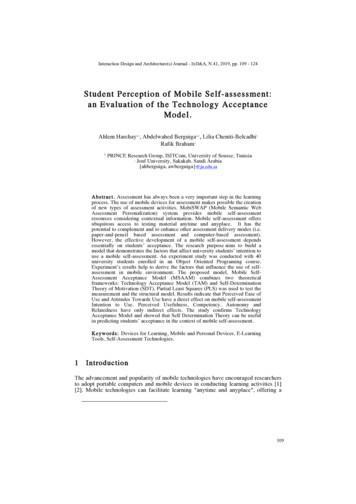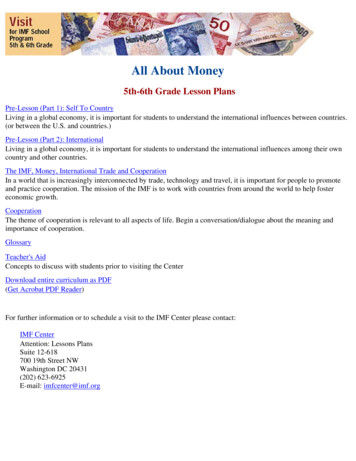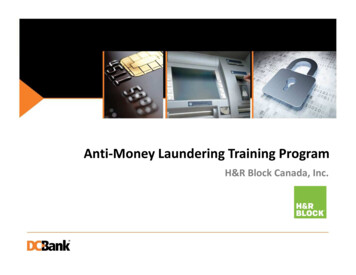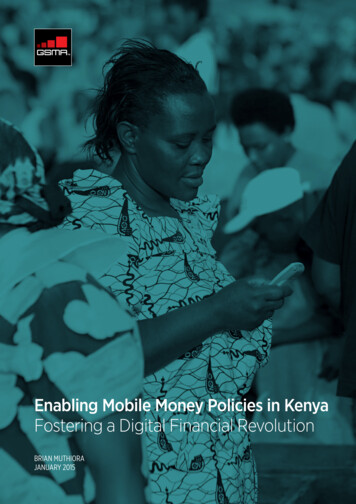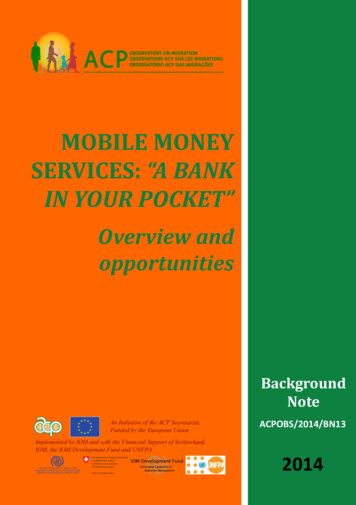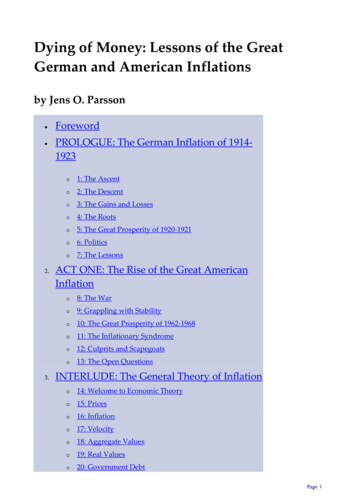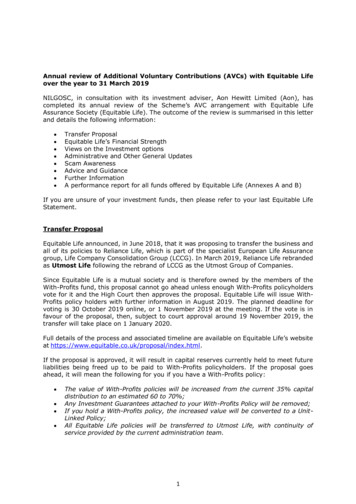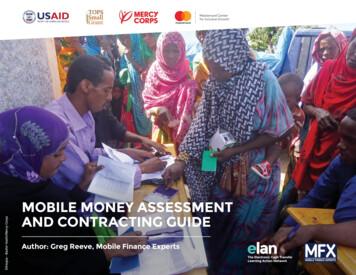
Transcription
Ethiopia – Bashir Hashi/Mercy CorpsMOBILE MONEY ASSESSMENTAND CONTRACTING GUIDEAuthor: Greg Reeve, Mobile Finance Experts
ELAN MOBILE MONEY ASSESSMENT AND CONTRACTING GUIDECONTENTSGLOSSARYGlossary2INTRODUCTION5How to use this guide5Getting started6Types of operators7An illustration of the mobile money process8PART 1: EVALUATING YOUR OPERATOR’S FIELD CAPACITY9Operator field capacity9Agent networks9Liquidity management10New customer registration11Customer service11PART 2: ASSESSING YOUR OPERATOR’S TECHNOLOGY11Operator technology and features12Selecting a mobile money operator14PART 3: ESTABLISHING EFFECTIVE CONTRACTSAND SERVICE LEVEL AGREEMENTS15The service delivery contract and annexes15The contracting process16Providing feedback on operator service20ANNEXES20AML (Anti-money Laundering) – A set of procedures, laws orregulations designed to stop the practice of generating incomethrough illegal actions. These may include limits on the amount ofmoney that can be held in a mobile wallet or limits on the number oftransactions that a user can perform per month.API (Application Program Interface) – A set of protocols for buildingsoftware and applications. By using an API, companies can automatecommunications between databases and mobile money platforms tosimplify the process of sending bulk transfers.(Automatic) Bulk Registration – Some jurisdictions allow the bulkregistration of customers with minimal Know Your Customer (KYC)information. Where allowed, bulk registration is valuable to programs,since it enables program participants to be registered for mobilemoney service rapidly and without direct contact with the operator.Some operators can perform bulk registration automatically fromreceipt of a participant list. Other operators complete bulk registrationusing a manual data entry process.B2P (Business-to-person) – A transaction from a business or NGO toa person; e.g., cash transfers or salary payments.Back-end (or back office) – The term mobile money operators use torefer to their processing technology and operations; back-end technologyis not directly accessed by the program participant/transfer recipient.Bulk transfer (or bulk payment) – A simultaneous transfer of fundsfrom one entity to many recipients. Bulk transfer services are requiredby almost all humanitarian agencies implementing mobile moneye-transfer programs.2
ELAN MOBILE MONEY ASSESSMENT AND CONTRACTING GUIDECash handling network – Mobile money systems rely on local agentsto distribute physical cash. Agents must maintain sufficient cash onhand (liquidity) to serve their customers’ cash-out needs. Typically,they access cash via local cash partners such as banks or aggregators(if the agent is part of a masteragent’s network). This group ofstakeholders involved in moving cash is referred to as the cashhandling network.G2P (Government-to-person) – A transaction between a governmententity and an individual; e.g., a social safety net payment.CICO (cash-in, cash-out) – In the context of mobile money, CICOdescribes the start and end of a money send transaction. Cash-in isthe process by which a customer credits his account with cash. Thisis usually via an agent who takes the cash and credits the customer’smobile money account. Cash-out is the process in reverse: acustomer deducts cash from his mobile money account. This is usuallyvia an agent who gives the customer cash in exchange for a transferfrom the customer’s mobile money account.1KYC (Know Your Customer) – Also known as customer due diligence,KYC regulations are designed to combat money laundering, terroristfinancing, and other related threats to the financial system. They referto the ID checks that financial institutions perform to comply withnational financial regulations. Typically, KYC checks take place whencustomers sign up for an account or conduct a transaction. However,KYC checks can also occur during events less visible to customers,such as creating customer transaction models and monitoring forunusual activity.E-money – Short for “electronic money,” is stored value held in theaccounts of users, agents, and the provider of the mobile money service.Typically, the total value of e-money is mirrored in (a) bank account(s),such that even if the provider of the mobile money service were to fail,users could recover 100% of the value stored in their accounts. Thatsaid, bank deposits can earn interest, while e-money cannot.2FSP (Financial Service Provider) – An entity that provides financialservices. Money transfer services are offered by a number of differentFSPs. Many mobile network operators provide mobile money serviceswith a dedicated staff supporting the service. Banks and otherproviders may also offer mobile money or other bulk transfer servicesfor humanitarian programs.IVR (interactive voice response) – An IT system that can betelephoned and guides the listener through a series of questions toaccess account information or conduct mobile money transactions.For example, “Press ‘1’ to send money,” “Press ‘2’ to cash-out,” etc.Liquidity – E-money and currency balances that agents must holdto provide cash-in or cash-out transactions; failure to hold sufficientbalance will restrict service quality, thus good operators strictlymanage liquidity.Manual vs. automatic processes for bulk transfers (operator side)– Some operators’ platforms automatically process bulk transactioninstructions. Others may use a manual procedure that can mimicthe bulk transfer operation, but can be as crude as a team of peopleconducting individual transfers on phones. Automatic processes areless error-prone than manual ones.1 GSMA. Mobile Money Definitions. July 2010. pdf2Ibid.3
ELAN MOBILE MONEY ASSESSMENT AND CONTRACTING GUIDEMasteragent (or aggregator) – An aggregator is a person orbusiness that is responsible for recruiting new mobile money agents.A masteragent is responsible for managing the cash and e-moneyliquidity requirements of a certain group of agents. Often, these rolesare combined and the two terms are sometimes used interchangeably.3P2B (Person-to-business) – A transaction between an individual and abusiness; e.g., a utility bill payment.P2P (Person-to-person) – A transfer from one individual to another;e.g., remittances.POS (Point of Sale) Device – Devices that do not contain any money,but have the capability of performing transactions (e.g., in retailstores, restaurants, or mobile locations.)Processing platforms – The technology used to manage the cashin, cash-out and transfer operations for all e-money use. Processingplatforms ensure messages are delivered and balances are accuratelymaintained. They also provide customers and agents with access totheir e-money through USSD or IVR. Part of the “back-end”.Service Delivery Contract – The legal agreement that defines the servicecommitment from the operator and how services will be delivered.SLA (Service Level Agreement) – An optional (but recommended)annex to the Service Delivery Contract. SLAs define in greater detailthe levels of service the operator will maintain.Transaction code – Most mobile money operators assign a uniquealphanumeric code to each transaction, which is used to confirmthe transaction between sender and receiver. Often this code isreferenced in the SMS sent to confirm a transaction has taken place.3Ibid.USSD (Unstructured Supplementary Service Data) – A method ofcommunicating with the mobile operator’s IT systems that is availableon nearly all GSM phones. Instead of dialing a number, USSD is a setof codes that allows the user to communicate with the IT system.Sometimes these systems show up as menu of options (see Figure 1as an example).FIGURE 1: USSD MENU EXAMPLE4
ELAN MOBILE MONEY ASSESSMENT AND CONTRACTING GUIDEINTRODUCTIONMobile money offers tremendous potential to enablecash transfers at scale and connect program participantsto financial services. Oftentimes, however, humanitarianpractitioners struggle to understand mobile moneyterminology to confidently evaluate different mobile moneyoperators and to design contracts that lay the foundationfor successful programs.Furthermore, the majority of humanitarian work currentlytakes place in locations with weak or disrupted paymentinfrastructure. Using mobile money in these contextsrequires careful assessments and joint planning with mobilemoney operators (hereafter “operators”)4 prior to, andthroughout, program implementation.Mobile money is a service in which a mobile phone is used toaccess financial services.5 Mobile money often includes the abilityto make payments, transfer money, or access insurance, creditor savings products through a mobile phone. Mobile money isa type of e-cash (or e-money), an electronic substitute for cashthat provides full flexibility for purchases. Humanitarian agenciesoften utilize mobile money bulk payments (or bulk transfers), asimultaneous transfer of funds to multiple participants.HOW TO USE THIS GUIDEThis guide is designed to help humanitarian practitioners understandmobile money operators’ capacities, evaluate potential providers anddesign strong agreements for successful program implementation.The guide is designed to help you understand the operator’sconstraints and challenges so that you can anticipate and mitigateimplementation challenges.The guide has an overview section and then is divided into three parts,each of which addresses a particular element of evaluating a mobilemoney operator or developing a successful partnership:Evaluating your operator’s capacity in the field (part 1) will helpyou assess your operators’ networks of agents and capacity to meetprogram participants’ needs. Will they provide training to new users?Will they have enough cash on hand to meet your program’s demand?Evaluating your operator’s technology (part 2) will help youevaluate what is happening “behind the scenes” at your potentialoperator(s). Is the mobile money service running on the best, most upto-date technology? Is your operator prepared to provide a reliable,problem-free platform for you and your program participants?Setting up Contracts and Agreements for Success (part 3) willhelp you review and structure agreements with your operator thatset expectations for service delivery and allow you to maintainaccountability during program implementation.The annexed Question Guide for Your Operator should be used tosupport assessments in part 1 (field capacity) & part 2 (technology4 Most ELAN resources refer to financial service provider (FSPs). Mobile money operators are as subset of FSPs that offer mobile-specific accounts and services, including mobile network operators(MNOs), banks, and marks56.pdf5
ELAN MOBILE MONEY ASSESSMENT AND CONTRACTING GUIDEAdditional annexes include a sample non-disclosure agreement(NDA), sample service delivery contract, and sample key performanceindicator (KPI) and audit reports.GETTING STARTEDBefore digging into the detailed advice of this guide, you’ll need toundertake an initial scoping to identify all operators in your programarea and select those to be assessed in detail. Your office may haveexisting contacts or interactions with some providers (for examplefrom previous programs or from your office’s own payroll services.)Your local staff and program participants are typically the best sourceof information about available options, especially which networksare reliable in program locations. In sudden-onset emergencies, youmay need to consider the damage to the relevant infrastructure. Youmay also want to consult your local Cash Working Group or refer to aresource such as GSMA’s deployment tracker.Initial scoping occurs early in program development – once you havedetermined that cash can be an effective tool to meet your programobjectives. It does not need to be time or resource-intensive and couldbe conducted even before funding is guaranteed.After identifying operators with good coverage in your program area,you will move to a more in-depth assessment of potential operators(described in more detail in the following sections of this guide).As you set up meetings with each relevant operator, prepare forthese discussions by making sure you can clearly communicate yourrequirements, including:T he number of program participants and their location(s)T he value and frequency of transfers, as well the planned orestimated transfer scheduleW hether the majority of your program participants currently haveaccess to a phone or SIM card and what network(s) they useW hat ID types most program participants possessT he general literacy and numeracy levels of yourprogram participantsBring this information to your meetings with potential operators,along with the questions in the Question Guide (Annex 1). As partof this in-depth assessment you will want to visit some of yourprogram locations to observe agents in the field and compare with thecapabilities promised by the operator’s head office.Following your in-depth assessment, you may select an operator andeventually develop a contract. Part 3 of this guide will be particularlyhelpful during the contracting phase.DRC – Sara Murray/Mercy Corpscapacity). The question guide offers suggestions for interpretingresponses, which you can use to identify operator strengths andweakness and build these into your program planning and servicedelivery contract.6
ELAN MOBILE MONEY ASSESSMENT AND CONTRACTING GUIDETYPES OF OPERATORSMobile money operators vary in their customer service and system capabilities. To help you judge the features offered, professionalism, and capacityof potential operators, we have developed three broad categories, which we refer to throughout this Guide:Operator CategoryTheir StrategyBest in Class“E-money builder”The most capable operators; their systems have been customizedto meet customers’ needs.These operators will be focused on building their e-money systemand will want your business as a part of an overall strategy. Theyunderstand that poor service will impede long-term customerusage and will only offer what they can deliver. These operators willask questions to determine your specific requirements and to fullyunderstand if they can deliver the required service.Average“Cash-in operators”The majority of mobile money operators; their capabilities arelimited by the back-end technology solutions they have selected,which are generally not customized for their users.These operators will be thinking about the low level of maturity oftheir own offering and will see you as an opportunity to increasecash flows into their system. They will view your participants as newsubscribers and may look to generate new transaction revenuefrom them. Average operators may not understand wider liquidityissues (further described in Part 1 - Evaluating Your Operator’sField Capacity) and may offer poor service without significantinvolvement from you.Poor & Troublesome“Any deal will do”Operators with the lowest maturity level; they have selectedcheaper, low-feature IT systems that lack sophisticated features.Often their service is delivered manually and prone to error, pooraudits, and bad operational quality.Oftentimes, these operators just want to win business and tend tooversell their capacity.7
ELAN MOBILE MONEY ASSESSMENT AND CONTRACTING GUIDEFIGURE 2: AN ILLUSTRATION OF THE MOBILE MONEY PROCESS FLOWBulk Transfer hAGENTDepositTransferOPERATOR’SIT ATOR’SBANKOPERATORCASH PARTNERParticipantBACK OFFICEMOBILE MONEY ECOSYSTEMLIQUIDITY MANAGEMENT8
ELAN MOBILE MONEY ASSESSMENT AND CONTRACTING GUIDEPART 1: EVALUATING YOUROPERATOR’S FIELD CAPACITYIn your initial scoping, you narrowed down your search to a group ofmobile money operators that provide good coverage in your programarea. Now, you are ready to conduct an in-depth assessment of theseoperators. Schedule meetings with each of the operators you areconsidering and, if possible, send them an overview document withcritical program details (noted above) in advance.6OPERATOR FIELD CAPACITYWhat is “field capacity”, and why is it essential to the success ofyour cash transfer program?Field capacity comprises the liquidity, customer service, registrationand agent network issues that have been recurrent challenges forhumanitarian programs using mobile money.7 These elements of fieldcapacity are critical for meeting program objectives and providing asmooth first experience for new mobile money users. Operators andhumanitarian organizations have a common interest in providingparticipants a positive first experience with mobile money.High quality field capacity is composed of four key elements:A gent networks: Does your operator have reliable agents whereyou need them?L iquidity management: Will those agents have sufficient cash onhand to meet the demands of your program?N ew customer registration and training: Will the operatorsupport registration and training of new customers (yourprogram participants)?C ustomer service: Are customer service mechanisms (for you andyour program participants) available and reliable?Low field capacity may leave you – and your program participants– confused and scrambling to make up for operator or agentshortcomings. Conducting a thorough initial analysis can help youidentify potential weaknesses early on, set expectations for allpartners and develop contingency plans.These four components of field capacity are explained below. Atthe end of each section, you’ll find a reference to a set of questions(Annex 1) for the operator head office and observations andquestions to use when visiting the operator in the field, as wellas categorization of responses by best-in-class, average and poorand troublesome.AGENT NETWORKSMobile money agents will directly interact with your programparticipants. As such, it is critical to understand if their presence isrobust enough to support your program needs, and if they are likelyto provide quality service. Questions for the operator in this sectionare aimed at understanding clearly where agents are located, whatvolumes of customers they serve currently and what kind of supportthey receive from the head office. You will also want to know if theagents in your program areas are mostly cash-in or cash-out agents or6 Note: your agency’s procurement procedures may indicate a different order or components of outreach and information sharing with providers.7Krishnan, Vaidehi. Partnering for Success: E-cash use in humanitarian programming. ELAN. 2015. or-success-in-e-cashfinal-elan.pdf9
ELAN MOBILE MONEY ASSESSMENT AND CONTRACTING GUIDEif they perform both tasks equally, since your program will require thesupport of agents with additional cash-out capacity.Temporary Expansion of Agent NetworksSome operators that lack sufficient agent presence in yourtarget area may offer to temporarily assign agents to disbursecash. This is a complicated undertaking and involves significantlogistics, security and management support from the operator.Typically, only a mature operator can successfully take onthis challenge, so treat with caution any promises of agentexpansion that are not accompanied with a full explanationof how it would be accomplished. Operators may also need tohave a strategic purpose to take on this added responsibility(such as leveraging your program to complement an existingagent expansion strategy) and could charge higher fees to coverassociated expenses.See Question Guide section 1.1 and 2.1 for questions andobservations for HQ and field agents about agent networks.LIQUIDITY MANAGEMENTMobile money agents must have sufficient cash (liquidity) available tomeet their customers’ cash-out demand. This is particularly true forcash transfer programs, where participants almost always cash-outtheir entire transfer upon receipt. Even businesses with high levels ofliquidity (such as pawn shops) may struggle to meet the demands oflarge cash transfer programs.For this reason, it is important to understand how your operator plansto support their agents in planning for, and meeting, your program’scash-out requirements. Liquidity management can consume 2030% of agents’ time.8 If liquidity management costs are not built intoyour operator’s business model, your program’s extra demands cannegatively impact cash recipients’ experience.Typically, agents can increase cash liquidity in two ways: either theagent goes to a bank or other cash point or receives a cash delivery(usually by an operator representative or masteragent).9 One or bothof these channels should figure in your operator’s liquidity planning.Talking about cash managementOperators may be reluctant to discuss specifics about theirliquidity management due to security concerns. Nevertheless,they should be able to provide general information thatdemonstrates a robust cash management system. If headoffice staff members are reluctant to discuss their liquiditymanagement in detail, you may need to triangulate informationby interviewing others involved in the process, such as agentsand intermediaries (i.e., banks, masteragents).See Question Guide section 1.2 and 2.2 for questionsand observations for HQ and field agents aboutliquidity management.8 Tool 5.6 - IFC Mobile Money Toolkit – ement.pdf?MOD AJPERES9A masteragent manages a group of agents, ensuring they have liquidity and are providing good service. Masteragents are rewarded with a percentage of their agents’ commissions.10
ELAN MOBILE MONEY ASSESSMENT AND CONTRACTING GUIDENEW CUSTOMER REGISTRATIONTo capture the potential benefits of using mobile money accounts forother transactions, program participants who are not already mobilemoney account holders must be registered with your operator.(See textbox on sending to unregistered recipients on page 12 fora possible work around in limited cases.) If bulk registration is notavailable in your location, the in-person registration process willrequire work from your field team and support from your operatorin the form of SIM card distribution, planning time, and technicalsupport. Your operator may welcome your registration of new clients.If you want the operator to play a role in the process, be clear aboutexpectations, roles and responsibilities for both field teams.See Question Guide section 1.3 and 2.3 for questionsand observations for HQ and field agents aboutcustomer registration.CUSTOMER SERVICEAll operators should provide an avenue for their customers totroubleshoot account difficulties, learn more about companyproducts, retrieve lost PINs, etc. Their customer service shouldextend to both you, as the humanitarian client, and your programparticipants, as product end users.See Question Guide section 1.4 and 2.4 for questions andobservations to clarify what type of support your operatorwill provide and interpretations of the reliability andaccessibility of that support.PART 2: ASSESSING YOUROPERATOR’S TECHNOLOGYYour operator’s overall capacity is also rooted in the technology theyuse and the features they offer. Understanding this aspect of youroperator’s business will help you evaluate their capacity to supportyour program’s objectives and identify any potential shortcomings.Key aspects of operator technology include: SMS notification: Can SMS that accompany bulk transfers becustomized for your program? Bulk registration: Can participants be registered in bulk? Payment platform and payer interface: How can your operatoraccept program participant details and payment instructions? Canyou directly access a platform to send transfers? Error messaging and retries: Under what conditions will atransfer fail? How are transfers retried? Error resolution: How are errors recorded and what is theresolution process? Reporting capabilities: What type of audit report does theoperator produce? What level of detail can they provide? Interoperability: Does the operator’s system enable transfers tousers registered with other operators?Across these technologies, you are looking for signs of whether theoperator has automatic or manual systems, as automatic systems willbe more reliable.11
ELAN MOBILE MONEY ASSESSMENT AND CONTRACTING GUIDENon-Disclosure Agreements (NDAs)Sending to an unregistered recipientSome operators operate in formal legal environments and maybe hesitant to provide details about their services (for exampleAPI or data file formats) without a signed NDA. A sample NDAcan be found in Annex 2.Any user outside the service provider’s network is an“unregistered recipient”. Additionally, not all network users (SIMcard holders) will have registered for the mobile money service.Most e-money systems permit sending to an unregisteredrecipient (within or off network); in these cases, the recipientmust withdraw the entire sent amount at the service provider’sagent, usually within a limited period of time. By contrast, aprogram participant registered with your operator will receivean SMS notifying them that money has been transferred totheir mobile wallet. Their wallet balance will increase to reflectthe transfer (minus any applicable fees). The registered userwill have the opportunity to withdraw their cash at an agentor can use the wallet to perform other financial transactions,such as sending money to another person or paying for goodsor services. An unregistered program participant will nothave access to additional mobile wallet capabilities and theremay be stricter limitations on the balance that can be sent tounregistered recipients (linked to AML/KYC regulations). Toregister for the mobile money service, users will have to undergoany relevant KYC checks. These are laid out in national legislationfor different banking and cash transfer services. For moreinformation about KYC in humanitarian programming, see theELAN KYC tip sheet.Each aspect of field capacity is explained below and linkedto a question for the operator’s head office (See Annex1 – Question Guide for questions on each of the featuresbelow and a categorization of responses).OPERATOR TECHNOLOGY AND FEATURESSMS NotificationSMS notifications are text messages that mobile phone holders canreceive from bulk or individual senders. Certain systems allow for theconfiguration of SMS notifications so that recipients can be notifiedin bulk that a transfer has been sent from a specific program. Thisfeature can be particularly useful when your program participants arealready utilizing mobile money (to differentiate program paymentsfrom other funds received).Bulk RegistrationSome systems are capable of registering your program participantsin bulk if they are not already registered, which provides them withadditional account functionalities. For either automatic or manualbulk registration, participants must possess (and in some cases youmust have collected) required KYC documentation for registrationto occur.Payment Platform and Payer InterfaceMost mobile money operators use an IT system to manage theiraccounts and transactions, referred to as a “payment platform.” Thepayment platform is often purchased from a specialist vendor, but12
ELAN MOBILE MONEY ASSESSMENT AND CONTRACTING GUIDEmay also be developed in house. Some payment platforms are quitebasic while others are more sophisticated. The file formats that youroperator can accept and whether or not they can schedule transfersfor a particular time offer insight into the sophistication and reliabilityof their system. Start and end dates of bulk payment transactionsSome services also provide programmable interfaces (known as APIs)so that NGOs’ or other providers’ IT systems can directly link to themobile operator’s systems. The identification codes for the individuals within the organization Bulk payment identification number(s) Any unique identifying name for the bulk payment (e.g. “Paymentsto Field Workers for Agriculture Program”)who acted as Generator, Verifier and Confirmer for the bulkpayment transaction The total payment amountErrors: Messaging, Retries and ResolutionAn error message is logged when transaction instructions are notprocessed correctly (resulting in no transfer sent to the intendedrecipient). There are a number of reasons why a transfer cannot becompleted, some of which are outside the operator’s control. Forexample, a transfer may fail if new money sent to a recipient exceedsthe mobile wallet’s permissible amount or as a result of a data entryissue. In these cases, some systems will retry the transaction beforerecording as a failure to send. Errors will be highlighted in your auditreport. Once resolved, the operator will be able to re-send the failedtransactions, but the ease of error resolution may vary significantlybetween operators.You also want to ask where the funds that you’ve provided for thetransfer will be held if the transfer fails. It is preferable to have fundsreturned to your account for re-use rather than being trapped in asuspense account until the errors are resolved.Reporting CapabilitiesAll systems should be able to produce a report that details transferssent for audit purposes. Some systems may have the ability to confirmthat a recipient has cashed-out their transfer. Reports should include: The total fees incurred Any errors, retries, and final resultsFor each recipient, reports should include: The recipient’s name The recipient’s mobile phone number Amount paid to recipient Fees, if any Transaction status (completed/in progress – refers to the transferbeing successfully sent by the operator, not the participant havingcashed out) Note: If sending to an unregistered participant, “inprogress” will appear until the user cashes out since there is no mobilewallet to
money operators (hereafter "operators")4 prior to, and throughout, program implementation. Mobile money is a service in which a mobile phone is used to access financial services.5 Mobile money often includes the ability to make payments, transfer money, or access insurance, credit or savings products through a mobile phone. Mobile money is
